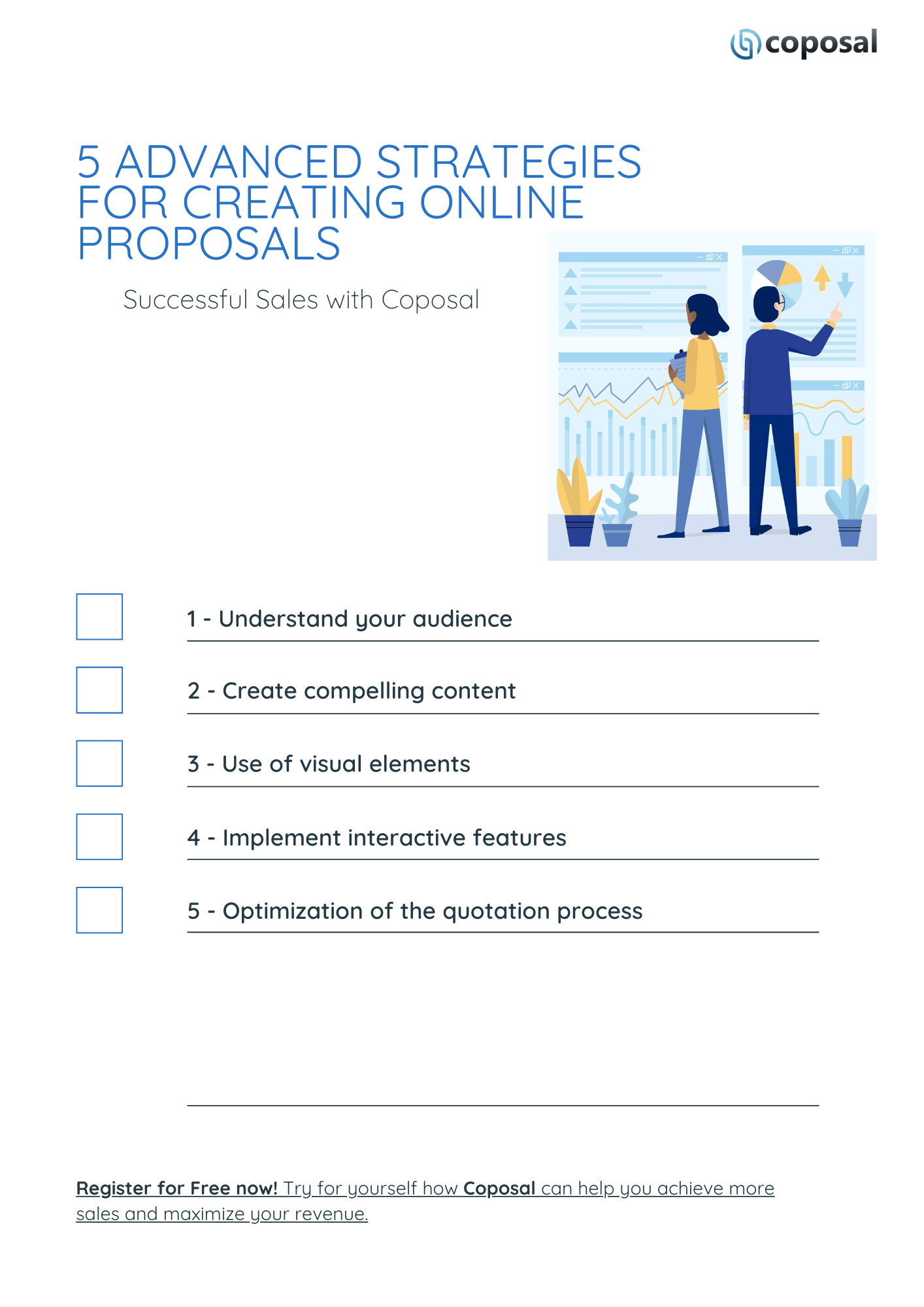
With increasing competitiveness in the online space, it is crucial to employ advanced strategies that stand out and effectively deliver value to potential customers.
This article looks at five strategies for creating online proposals that are sure to increase your success rate and impress your potential customers.
Table of Contents
Understanding online proposals
 The use of online proposals has become a cornerstone of business interactions.
The use of online proposals has become a cornerstone of business interactions.
Whether you're a freelancer, small business owner, or corporation, mastering the art of creating compelling online proposals can dramatically improve your chances of landing new clients and projects.
Unlike traditional paper or .PDF offerings, online offerings are dynamic, interactive and easy to share, making them more versatile and effective in a digital environment.
The quality of your proposals can determine the success or failure of your business deals. An effective online proposal demonstrates your professionalism, expertise and understanding of the customer's needs and ultimately influences their decision-making process.
By investing time and effort into developing sophisticated offerings, you demonstrate your commitment to creating value and thereby increase your chances of success.
 Reading recommendation: Further basics and requirements for the creation and management of online offers can be found in our blog article "Evaluate the efficiency of your proposals - what reporting options online proposal software should have."
Reading recommendation: Further basics and requirements for the creation and management of online offers can be found in our blog article "Evaluate the efficiency of your proposals - what reporting options online proposal software should have."
1 - Understand your audience
A fundamental strategy in creating an effective offer is understanding your audience.
Therefore, before developing your offer, take the time to research your potential customer's needs, preferences and pain points.
By gaining insights into their business goals and challenges, you can tailor your offering to their specific needs, increasing its relevance and impact.
 Reading recommendation: "Personalize your proposals with Coposal - Stand out from the crowd."
Reading recommendation: "Personalize your proposals with Coposal - Stand out from the crowd."
Researching customer needs and preferences
 First, conduct thorough research about your potential client's industry, target market, and competitors.
First, conduct thorough research about your potential client's industry, target market, and competitors.
Determination of weak points and pain points
In further research, identify key pain points, challenges, and objectives to gain a deeper understanding of the business landscape.
Tailor-made offers for the target group
Once you've gathered enough insights, tailor your offer to your customer's preferences and expectations.
Use language and terminology that fits their industry, address their pain points, and offer relevant solutions.
By demonstrating that you understand the unique challenges, you build credibility and trust and lay the foundation for a successful partnership.
This information also serves as a basis for developing a tailored proposals that meets your needs and priorities.
 Reading recommendation: In our blog article "Coposal for various industries - Customized proposal solutions" we show how you can adapt your offers for your industry and make them successful.
Reading recommendation: In our blog article "Coposal for various industries - Customized proposal solutions" we show how you can adapt your offers for your industry and make them successful.
2 - Create compelling content
The success of an online proposal depends on its ability to effectively communicate your value proposition.
To capture your audience's attention and interest, focus on creating compelling content that clearly and succinctly highlights the benefits of your proposal.
Structure the offer effectively
 A well-structured proposal follows a logical flow and guides the reader through the most important information in a coherent manner.
A well-structured proposal follows a logical flow and guides the reader through the most important information in a coherent manner.
Start with a compelling introduction that grabs attention and sets the stage for what's to come. This is followed by sections that outline your understanding of the customer's needs, your proposed solution, and the benefits of working with you.
Finally, close with a strong call-to-action that encourages the reader to take the next step.
Highlight unique selling points
Differentiate your offer by highlighting your unique selling points and competitive advantages.
Whether it's your industry expertise, your innovative approach, or your track record, emphasize what sets you apart from the competition.
Presentation of past success stories
 One of the most effective ways to inspire trust in your offering is to showcase past success stories and customer testimonials.
One of the most effective ways to inspire trust in your offering is to showcase past success stories and customer testimonials.
Highlighting your track record of delivering exceptional results reassures the client that you have your skills and expertise.
Include case studies or testimonials that show how your solutions have positively impacted previous customers.
This social proof strengthens your credibility and convinces the customer to choose your services.
3 - Use of visual elements

Incorporating visual elements into your offer can significantly increase its appeal and effectiveness.
By using graphics, charts, images, and multimedia, you can convey complex information more effectively and leave a lasting impression on your audience.
Integration of images to improve the presentation
Visuals serve as powerful tools for conveying information quickly and intuitively.
Use graphs and charts to illustrate key data points, trends, or forecasts relevant to your proposal.
Incorporate high-quality images and graphics to complement your written content and add visual interest.
However, ensure your imagery is relevant, professional and consistent with your brand identity to maintain consistency and credibility.
Use graphics, diagrams and images effectively
 When choosing visual elements for your offer, focus on clarity and relevance.
When choosing visual elements for your offer, focus on clarity and relevance.
Choose graphics and charts that simplify complex information and make it easier to understand. Choose high-resolution images that increase the visual appeal of your offer and emphasize your core messages.
Integrate multimedia content
Additionally, consider incorporating multimedia elements such as videos or interactive presentations to engage your audience and bring your offering to life.
4 - Implement interactive features
In today's digital landscape, interactivity is key to capturing and retaining audience attention.
By integrating interactive elements into your online offerings, you can offer your readers a more engaging and immersive experience.

Adding interactive elements to the interaction
Incorporate interactive features such as clickable buttons, drop-down menus, or interactive forms to encourage user engagement and interaction.
Allow readers to seamlessly navigate your proposal, access additional information, or provide feedback directly within the document.
By giving readers the opportunity to actively interact with what you have to offer, you create a more personal and memorable experience that speaks to them on a deeper level.
Including clickable links and multimedia
Expand the functionality of your proposal by including clickable links to relevant resources, additional content, or external references.
Direct readers to your website, portfolio, or social media profiles to learn more about your offerings and credentials.
Additionally, you can embed multimedia elements such as videos, audio clips or interactive presentations to enrich the content and provide a multi-dimensional experience.
By incorporating different media formats, you cater to different learning preferences and increase the overall effectiveness of your proposal.
 Reading recommendation: You can find more information about integrating and implementing interactive functions in your offers in our blog article: "Increase your success with Coposal - Interactive features in online proposals."
Reading recommendation: You can find more information about integrating and implementing interactive functions in your offers in our blog article: "Increase your success with Coposal - Interactive features in online proposals."
5 - Optimization of the quotation process
 Efficiency and convenience are the focus when submitting offers online. To streamline the proposal process and maximize your chances of success, leverage templates, automation tools, and best practices that speed document creation and submission.
Efficiency and convenience are the focus when submitting offers online. To streamline the proposal process and maximize your chances of success, leverage templates, automation tools, and best practices that speed document creation and submission.
Use of templates and automation tools
Save time and effort by using pre-built proposal templates that provide a framework for structuring your content.
Customize the template with your branding elements, content, and visuals to create a polished and professional-looking proposal in minutes.
Additionally, use automation tools such as proposal software or CRM platforms to streamline document creation and tracking.
By automating repetitive tasks and administrative processes, you free up time to focus on high-value activities like customer retention and business development.
 Recommended reading: Our blog article "How to integrate branding into online proposals with Coposal's brand and team management." deals with the "why", shows you common procedures and highlights the challenges that come with implementation.
Recommended reading: Our blog article "How to integrate branding into online proposals with Coposal's brand and team management." deals with the "why", shows you common procedures and highlights the challenges that come with implementation.
Simplifying the submission process
Make it easy for your customers to review and respond to your offer by providing multiple submission options.
Offer both online and offline delivery methods such as email, web forms, or digital signature platforms to accommodate different preferences and workflows.
Make sure your offer is accessible across devices and platforms so customers can view it seamlessly on desktops, laptops, tablets or smartphones. Provide clear instructions and guidance on reviewing and accepting the offer to minimize friction or barriers to acceptance.
 Reading tip: If our article helped you and you would like to find out more about creating online proposal, we recommend our little guide: “Key elements of online proposals”
Reading tip: If our article helped you and you would like to find out more about creating online proposal, we recommend our little guide: “Key elements of online proposals”
Summary
Mastering the art of creating online listings is critical for businesses that want to succeed in today's competitive marketplace.
By understanding your audience, creating compelling content, leveraging visuals, incorporating interactivity, personalizing your approach, and streamlining the proposal process, you can create compelling offers that resonate with customers and drive business growth.
Frequently asked questions about creating online offers
Why are online offers important for companies?
Online offerings allow companies to present their offerings in a dynamic and interactive format, increasing engagement and increasing the likelihood of acquiring new customers or projects.
How can I effectively personalize my online proposals?
Personalization is about tailoring your offers to address each customer's specific needs, preferences, and concerns.
This can include addressing the customer by name, referencing previous interactions, and tailoring the content of the offer to their industry and goals.
What are some best practices for creating visually appealing proposals?
When creating online proposals, focus on using high-quality images, graphics, and multimedia elements to enhance the visual appeal and engagement of your document.
Make sure your visuals are relevant, professional and aligned with your brand identity to create a cohesive and impactful presentation.
How can automation tools help streamline the quoting process?
Automation tools like quoting software or CRM platforms can streamline document creation, tracking, and follow-up, saving businesses time and effort.
These tools automate repetitive tasks and administrative processes, allowing companies to focus on high-value activities such as customer retention and business development.
What common mistakes should you avoid when creating online proposals?
Common mistakes to avoid when creating online proposals include using generic templates, failing to personalize content, overwhelming the reader with too much information, and failing to follow up immediately after submission.
It's important to tailor your offerings to each customer's specific needs and preferences and provide clear, concise, and compelling content that highlights the value of your proposal.